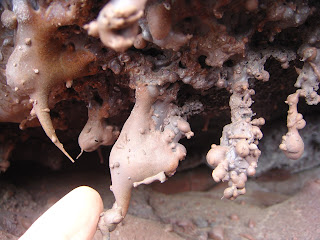We were at Redd, a highly-touted restaurant in the Napa Valley north of San Francisco. We hadn't planned to eat there -- usually it takes a reservation weeks in advance -- but the personnel at a nearby wine-tasting establishment suggested we try the restaurant's bar, which serves wonderful appetizers and doesn't require a reservation. When we arrived we found to our surprise there was an unexpected open table in the main restaurant, and we opted for that instead.
Good choice.
Early in the meal the waiter brought a special appetizer, complements of the chef. He described it as "
yellowfin tuna tatar with asian pear, avocado, chili oil, fried rice, and cilantro."
Hmmm... "Tatar," of course means "ground up and raw." For most of my life the idea of eating raw tuna would have been acceptable only if I was stranded on a desert island and near death from starvation. Since moving to Hawai'i (which is most definitely
not a desert island) and having access to excellent fresh seafood, I've found that certain types (not all) of raw or lightly cooked seafood have a texture and flavor that is amazingly tasty. But it isn't just the flavor of the fish that I've come to appreciate, it's also the subtle, complex and surprisingly unique flavors and textures that a talented chef can create in the total preparation of spices, sauces and other ingredients -- in this case the fried rice (actually more like puffed), the pear and avocado, and the chili oil and cilantro. This appetizer had it all -- delicious!!

By the way, the rest of our meal at Redd was equally subtle, complex, and just as likely as raw fish to be something I would have shunned in earlier years: chestnut soup with roasted apples and brown butter, a beet salad with gulf shrimp, pomegranate seeds, fennel, watercress and yucca chips, and a main dish of rare Sonoma duck breast with cranberry spaetzle, sunchoke, spinach, and duck consomme. All terrific!

In my youth I had strong and rather simple taste preferences. If it was salty, greasy, and over-cooked I liked it (well, except for liver & onions, but that's another blog). My mother, who did most of the cooking in our family, was raised on a Midwestern farm and learned to prepare simple, straightforward, and very satisfying dishes like pot roast, pork chops, fried chicken, and baked ham. Slightly more exotic were her tuna casserole, macaroni & cheese, meatloaf, spaghetti & meatballs, and Swiss steak. The only fish dishes I can remember were pan fried trout and baked fish sticks, neither of which I liked. Since we couldn't afford to eat at restaurants very often this was my culinary world for many years.

It wasn't really until my wife and I began traveling abroad, which we started doing shortly after we were married and have continued ever since, that I was exposed to different and more complex food. These travels also introduced us to cultures where the preparation, presentation, and enjoyment of food was a highly developed norm, like Italy and France. About the same time we joined a "gourmet" dinner group that met several times a year. Each dinner menu was chosen by a committee and different dishes were assigned to different members for preparation. The result was a combined meal that would have been very difficult for any single person to produce, and it offered us the chance to sample a number of dishes we would not have attempted for ourselves. It also produced social pressure to at least taste foods I never would have tried on my own. As our experience grew my wife became an adventurous and accomplished cook and her enjoyment of preparing a wide range of dishes means that we eat very, very well at home these days. I pay for her efforts by being the clean-up crew.

Another contributing factor to my willingness to seek out new dishes is that my wife and I never order the same thing in a restaurant. We pick things from the menu that we will share, and usually we look for interesting items on the appetizer menu. For instance, we might have two or three appetizers and one main course. That way we get to try more things and compare our reactions.

So over the years my appreciation for well-prepared, creative, subtle and complex food has grown stronger and stronger. It was a slow process with many dead-ends, disappointments and sometimes unfinished dishes. But frankly I'm glad it took so long because now I think I value good food even more and don't take it for granted. An illustration of my evolution is that one of my favorite recent movies is the 2007 Disney animated film
Ratatouille, in which a Paris rat (yes, RAT) dreams of becoming a world-class chef. His family naturally doesn't understand his odd appreciation for food that isn't garbage. One scene I particularly like occurs early in the movie, when the main character (Remy) tries to explain to one of his brothers the magic of food and flavor. Different flavors can be wonderful when tasted separately, he points out, but when they are combined in just the right way they produce something greater and infinitely more enjoyable than any single ingredient. His brother nods in feigned understanding and then returns to eating his garbage.
I need to make it clear that there are limits to my culinary explorations. First, I'm not eager to try anything just because it's different or exotic or I've never eaten it before. My threshold for organ meats, for example, is very, very high. And just because someone exclaims how good something is isn't enough -- some people will eat ANYthing. Second, I'm too cheap to ever enjoy a $200+ meal -- my palate can't possibly be refined enough to consider that worthwhile. In fact, some of the best food I've had has been at rather modest places. For instance, another meal we enjoyed beside the one at Redd on our California trip was in a small family-run restaurant that served some of the best Mexican food I've ever tasted -- total cost $10. Third, I choose not to eat certain kinds of food for philosophical reasons -- see my blog on
The Reluctant Carnivore Diet.

According to the NIMH's
Medline, when we are young have about 9,000 taste buds on our tongues that detect flavors. Unfortunately this number decreases after age 40-50 for women and 50-60 for men, and those taste buds that remain atrophy. Sensitivity to the four tastes -- salty, sweet, bitter and sour -- often decreases beginning around age 60. The exact reason for this decline isn't known: "Studies about the cause of decreased sense of taste and smell with aging
have conflicting results. Some studies have indicated that normal aging
by itself produces very little change in taste and smell. Rather,
changes may be related to diseases, smoking, and environmental exposures
over a lifetime." To the best of my knowledge, there isn't anything you can do to stave off this decline.

So the sad fact is that I now have the experience and appreciation for good food that has taken me most of my adult life to acquire, yet my tasting equipment may be wearing out! This isn't certain -- the loss of taste buds may not get to the point of interfering with my enjoyment of eating, but the possibility isn't pleasant to consider.
When I was young I may have had 9,000 taste buds but I really didn't know enough to put them to good use. As I now begin to lose them, for me the conclusion is clear:
Taste buds are wasted on the young!







